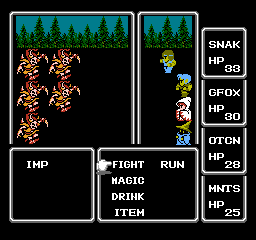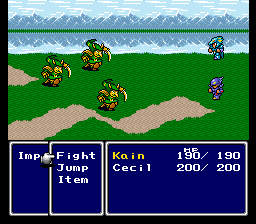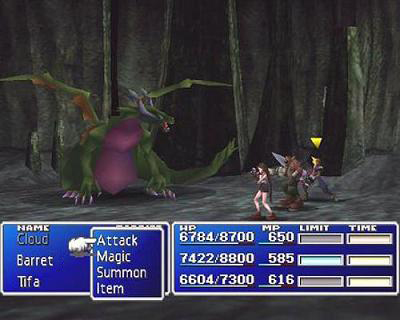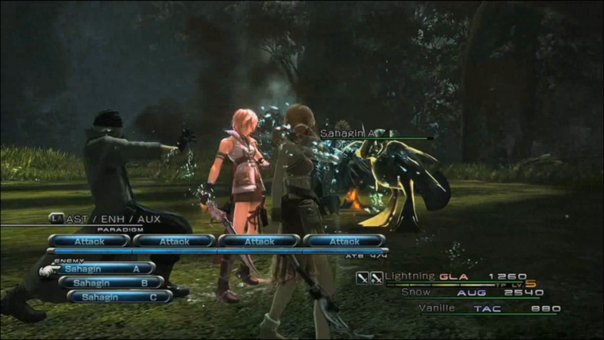There is a gradient of abstraction in RPG combat systems; at one end you have the pure turn-based systems, in which you choose from a defined set of possible actions and the result is simulated, e.g. the original Final Fantasy; at the other end you have pure action systems, like Dark Souls, in which every facet of the action is determined by your fine-grained input on movement and timing. There is also a gradient in the combinatorial complexity of decision making in RPGs. Depending on the design a character may have a handful of spells and items to choose from, or hundreds.
The interface by which the player navigates the game’s decision tree and executes their plan of attack should reflect how abstract and how combinatorial the combat system’s design is. This old Penny Arcade strip about Final Fantasy 12’s Gambit system, while in my opinion not a very smart take on FF12 per se, makes the point that game interfaces are not one-size-fits-all.

Until taking screenshots for this post I had forgotten about the existence of “Drink.”
Japanese RPGs began as (and in some studios’ catalogs, continue to be) highly abstract games with moderately deep complexity; in the original Final Fantasy for NES you can face upwards of eight enemies in a battle, spellcasters might have a dozen or two spells, and there are three types of usable item. Given that the NES controller has just a directional pad and four buttons, a nested menu interface was probably the only sensible choice for FF1. For each layer of the decision tree a menu lists the available choices; you scroll through until you find the choice you want and hit A to confirm. Since then, menus have been a mainstay of JRPGs – even when the underlying gameplay shifted.
Square’s first Super Nintendo entry in the series, Final Fantasy 4, introduced the Active Time Battle system. Unlike previous installments, FF4 considers a “turn” to be a character-specific event, with a frequency independent of other characters’ turns. Inspired by watching Formula One racers lap each other, the designers gave each character a speed which determined how often they could take action. Each player character (and enemy) has a meter that fills up over time according to their speed; when the meter is full, they are ready to receive input. Status effects can speed up, slow down, or even stop individual characters’ meters. Depending on which action the player selects, the character spends a certain amount of time preparing the action and then executes it – powerful magic takes several seconds, while a basic attack or item is nearly (but not quite) instant. A caster with a sliver of health remaining might not survive the prep time required to perform a battle-ending spell. The decision tree looks essentially just like the original Final Fantasy’s, with more spells, more items, and time simply being another factor to weigh against others.
The ATB system made battles far more engaging and fast-paced than the original Final Fantasy, never going more than a few seconds without requiring the player’s input, and it certainly succeeded in increasing the series’ appeal. Though the long spellcasting times were abandoned after FF4, Square kept the core conceit of ATB around for each of its SNES and Playstation Final Fantasy games, plus perennial “best RPG ever” contender Chrono Trigger. When an American gamer thinks “JRPG”, their mental archetype is probably a game with Active Time Battle.

The new mechanic introduced by FF4 is not visible in the interface.
I hate Active Time Battle. I also think it’s objectively bad, which is not the same thing, but the reasons for both are the same.
Here’s an extreme hypothetical scenario to demonstrate what drives me crazy about ATB. At the end of a grueling battle, you have one surviving character with 1 HP, facing one remaining enemy also with 1 HP. Your character’s ATB meter fills up slightly before the enemy’s. If you can hit the “confirm” button twice – once to select Attack, once to select the target – in the gap between the menu popping up and the enemy starting its attack action, you win. If you can’t, game over. The “time management” skill that ATB demands from the player extends to managing the time your fingers take to enter inputs through the menu system – introducing a twitchy, execution-centric challenge into a game with an interface designed for complex, abstract decision making. Best of all, in the original version of FF4 you can’t even see the meter to anticipate the appearance of the menu! I have lost many a Final Fantasy battle because of split-second delays in my input, because Square chose not to stop the timer while the menu is open.
What’s most peculiar about this problem, to me, is the existence of Wait mode. In the settings menu of every game with ATB is a toggle between Active mode, in which time continues to pass no matter how deep you go into the menus during battle, and Wait mode, in which time pauses when you are browsing the lists of spells or items, as a concession to people who might not enjoy the gaming equivalent of looking up names in a phone book on a time limit. The international release of FF4 – notoriously rebalanced, simplified, and called “Final Fantasy 2” so as not to overwhelm Western players who missed the Japan-only sequels that expanded on the systems of the original – actually doesn’t offer a choice: the game is in Wait mode, period. U.S. gamers first got a taste of Active mode in FF6 (sigh, “3”).
In FF7, Wait mode expanded to include target selection for basic attacks, but time continues to pass on the primary Attack-Magic-Item menu and so requires at least one quick-trigger button press to avoid wasting time; meanwhile what had been called Wait mode in previous FFs was rebranded “Recommended” and became the default option. So Squaresoft wanted to give players some control over how much pressure there was to navigate menus quickly, and even considered that to be the default experience players should have, but always stopped short of including an option to remove the pressure entirely. Why?

FF7 took one more step towards eliminating twitch from ATB, but stopped short.
Many fans of the series say that they don’t play Active Time Battle games in Wait mode because it makes combat “too easy” – and they could well be right. The roughest Final Fantasy is a tea party compared to the brutality of the friendliest Atlus RPG. Difficulty is subjective, of course, so games have different settings to let players choose their level of challenge; it’s not much of a stretch to call Active mode Final Fantasy’s “veteran” setting for players who would breeze through the game otherwise. Square’s decision to remove Active mode from the “Easy Type” international version of FF4 is certainly suggestive.
But the history of game design is littered with cheap, lazy, artificial solutions to making a game more challenging. I’m reminded of how the survival horror genre clung to unintuitive tank controls long after consoles had overcome the technical limitations that necessitated them; the die-hards who defend tank controls argue that making it harder to run away from enemies adds to the tension. Yes, having to input a Killer Instinct combo to cast Fire-3 before my mage gets his face ripped off increases the difficulty. Taping my fingers together or putting on a blindfold would also increase the difficulty.
Wouldn’t it be more interesting if the game became harder because I couldn’t bring 99 of every healing item into the final boss fight? Call me crazy, but how about tuning the numbers that comprise your game – you know, balancing it – until it’s as hard as it’s supposed to be? Etrian Odyssey can afford to give me all the time I want to make a decision, because the margin for error is tiny even in a random battle against enemies at your level. ATB is a crutch, substituting twitch gameplay for strategic depth.

FF13’s revision of ATB is just as fast-paced, but de-emphasizes the speed of your menu input.
Although my taste in RPGs definitely runs toward pure turn-based games where I can consider options carefully, I don’t mean to suggest that decision making on the clock has no place in RPGs. Final Fantasy 13 represents a substantial improvement over ATB in the compromise between menus and a fast pace of action. Crucially, the player can input commands while the character’s action meter fills, so even though time passes in the menu, that time is not necessarily wasted – it may even be to your advantage to delay the execution of your queued commands to synergize with your AI-controlled teammates. By contrast, only in rare boss battles is it ever strategically sound to spend more than the minimum possible time in menus in FF4.
To be fair to Final Fantasy, the combat system fundamentally works, despite this one thing that makes me hate it so much. Now could someone explain to me why KINGDOM HEARTS, a fully real-time action RPG, makes you pick attacks from a goddamn menu?
